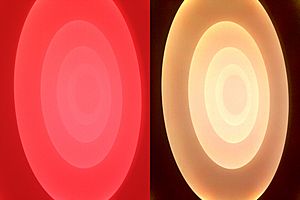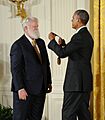James Turrell facts for kids
Quick facts for kids
James Turrell
|
|
|---|---|
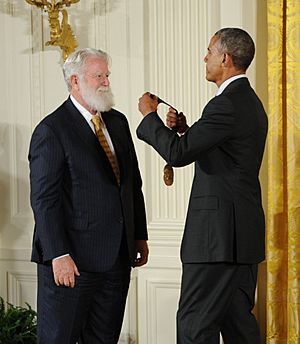
President Barack Obama presents the National Medal of Arts to Turrell in 2014
|
|
| Born | May 6, 1943 Los Angeles, California, US
|
| Alma mater | Pomona College University of California, Irvine Claremont Graduate University |
| Known for | Installation art |
|
Notable work
|
Roden Crater, Acton |
| Movement | Light and Space |
James Turrell (born May 6, 1943) is an American artist. He is famous for his work in the Light and Space art movement. People often call him the "master of light." He creates amazing art installations that mix natural light with artificial colors. These artworks change how indoor spaces look by using light that shifts and moves.
A big part of Turrell's career has been spent on Roden Crater. This is a natural volcano crater near Flagstaff, Arizona. He is turning it into a giant observatory where people can watch the sky without telescopes. He is also known for his "skyspaces." These are special enclosed rooms that frame the sky, making it look like a painting.
Turrell was born in Los Angeles, California. He grew up in a Quaker family. He got his pilot's license when he was 16. Later, he flew Buddhist monks out of Tibet. He studied perceptual psychology at Pomona College. He also learned about math, geology, and astronomy. He started experimenting with light art while studying at the University of California, Irvine. This early work helped him create his famous light installations.
Turrell's unique way of using light and space has won him many awards. These include being named a MacArthur Fellow in 1984. His artworks explore how we see and understand light. They have been shown in major museums and public places all over the world.
Contents
Early Life and Education
James Turrell was born in Los Angeles, California. His father, Archibald Milton Turrell, was an engineer and teacher. His mother, Margaret Hodges Turrell, was a medical doctor. Both of his parents were Quakers.
Turrell got his pilot's license when he was 16 years old. During the Vietnam War, he chose not to fight. Instead, he flew Buddhist monks out of Chinese-controlled Tibet. He called this a "humanitarian mission." For many years, he fixed old airplanes to help pay for his art projects.
He earned a bachelor's degree in perceptual psychology from Pomona College in 1965. He also studied mathematics, geology, and astronomy. In 1966, he started a graduate art program at the University of California, Irvine. This is where he began making art using light. His studies were interrupted when he spent about a year in jail. In 1973, he received a master's degree from Claremont Graduate University.
Artistic Journey
First Light Artworks
In 1966, Turrell started experimenting with light in his studio in Santa Monica. This was when a group of artists in Los Angeles, called the Light and Space group, became well-known. Turrell covered his studio windows. He only let certain amounts of light from outside come through small openings. This is how he created his first light projections.
In 1968, he made Shallow Space Constructions. For these, he used screens to create a soft glow of hidden light. This made the space look flat in an interesting way. That same year, he worked with the Los Angeles County Museum of Art. He explored how people see things with artist Robert Irwin and psychologist Edward Wortz.
From 1969 to 1974, Turrell created The Mendota Stoppages. He used several rooms in the old Mendota Hotel in Santa Monica. He sealed off these rooms and controlled the window openings. This allowed natural and artificial light to enter the dark spaces in special ways.
Roden Crater Project
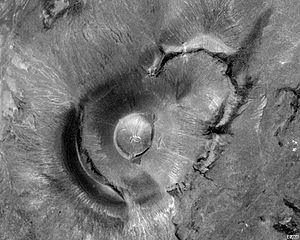
In 1979, Turrell bought an extinct volcano called a cinder cone. It is located near Flagstaff, Arizona. Since then, he has spent decades moving tons of dirt. He has also built tunnels and openings. His goal is to turn this crater into a giant observatory for experiencing the sky.
The Crater project has been ongoing for a long time. Access to Roden Crater has been very limited. It was mostly open to the artist's friends. However, in May 2015, a small group of 80 people could visit for a high cost.
Turrell does not see himself as an "earthworks" artist. He explained, "I make things that take you up into the sky. But it's not about the landforms. I'm working to bring celestial objects like the sun and moon into the spaces that we inhabit." He added, "I apprehend light—I make events that shape or contain light."
In 2019, Turrell started working with Arizona State University. This partnership is called the "ASU-Roden Crater Project." They hope to use the university's resources to help with the project.
Skyspaces
In the 1970s, Turrell started his "skyspaces" series. These are enclosed rooms with an opening in the roof that looks up at the sky. A Skyspace is usually big enough for about 15 people. Viewers sit on benches around the edges and look up at the sky through the opening.
As a lifelong Quaker, Turrell designed the Live Oak Meeting House. It has a "skyhole" in the roof. Here, light takes on a special meaning. His work Meeting (1986) at MoMA PS1 is a copy of such a meeting house. In 2013, Turrell created another Quaker skyspace, Greet the Light, in Philadelphia.
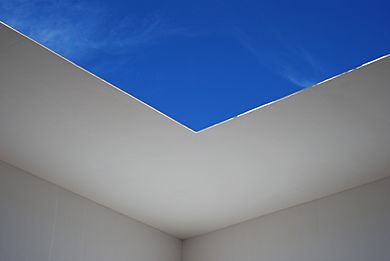
A New York Times article described a skyspace as a "celestial viewing room." It is designed to make the sky seem close enough to touch. It looks like the sky is stretched across an opening in the ceiling.
In 1992, Turrell's Irish Sky Garden opened in Ireland. This huge artwork has a crater in its center. Visitors walk through a passage and climb stairs. Then they lie down on a central platform and look up. The rim of the crater frames the sky. Turrell said, "The most important thing is that inside turns into outside and the other way around."
Since 2009, Turrell's Third Breath, 2005 has been on display. It is part of the permanent collection at the Centre for International Light Art in Unna, Germany. It is a camera obscura with two rooms. In the lower room, visitors see an image of the sky reflected on the ground. In the upper room, they can see the sky directly through a hole in the ceiling.
Three Gems (2005) at the de Young Museum is Turrell's first Skyspace shaped like a stupa. At Houghton Hall in England, Turrell created a Skyspace that looks like an oak building on stilts. Inside, viewers look up at the sky framed by the open roof.
Turrell's Dividing the Light (2007) includes water and landscaping. This Skyspace is an open-air pavilion at Pomona College. It has a canopy with an opening, special lighting, a pool, and plants. The opening in the canopy reflects the pool below.
Other Skyspaces can be found in many places. These include the Kielder Skyspace (2000) in England and Knight Rise (2001) in Arizona. There is also Sky Pesher (2005) at the Walker Art Center and Within Without (2010) in Australia. More recent ones include the Skyspace Lech (2018) in Austria and the Green Mountain Falls Skyspace (2022) in Colorado.
In 2023, the Walker Art Center updated its Sky Pesher work. They replaced the old lights with new LED lights. This allows for a wider range of colors. The seats in this artwork are also heated.
Other Artworks
In 2008, Turrell designed an indoor pool in Connecticut. It makes you feel like you are swimming in a box of mirrored light.
In 2009, the first museum dedicated to Turrell's work opened in Argentina. It is part of the Hess Collection at Colome. The museum has nine light artworks. They show five decades of the artist's career. The experience ends with a beautiful skyspace. It offers amazing views of the Andean sky at sunrise and sunset.
Turrell is also known for his light tunnels and projections. These create shapes that seem solid, but they are made only of light. Three of these works are permanent at the Mattress Factory in Pittsburgh, Pennsylvania. His 1968 projection of a pink pyramid, Raethro Pink, is owned by the Welsh National Museum of Art.
His work Acton is very popular at the Indianapolis Museum of Art. It looks like a blank canvas on display. But the "canvas" is actually a rectangular hole in the wall. It is lit up to look like a solid surface.
Turrell believes that people often look at art too quickly. He feels that viewers need to spend more time with his art to truly appreciate it. He once said, "Maybe we could also have a slow-art movement, and take an hour."
Exhibitions
Turrell had his first solo show in 1967 at the Pasadena Art Museum. Since then, his art has been shown in many famous museums. These include the Stedelijk Museum (1976) and the Whitney Museum of American Art (1980). His work has also been seen at the Israel Museum (1982) and the Museum of Contemporary Art, Los Angeles (1984).
The Wolfsburg Project was Turrell's largest exhibition in Germany. It opened in October 2009. It included a "Ganzfeld" work. This is a light installation that covers a huge area. Also in 2009, his artwork Third Breath, 2005 opened at the Centre for International Light Art in Germany.
A major exhibition called James Turrell: A Retrospective showed his 50-year career. It was at the Los Angeles County Museum of Art from May 2013 to April 2014. It then traveled to the National Gallery of Australia.
From June to September 2013, the Solomon R. Guggenheim Museum in New York held a James Turrell exhibition. It was his first in a New York museum since 1980. The exhibition focused on how he explores light, color, and space. A new project, Aten Reign (2013), transformed the Guggenheim's famous rotunda. It filled the space with changing artificial and natural light.
In early 2017, his work was featured in the exhibition Immersive Light in Shanghai. Into the Light, an installation of nine Turrell works, has been on view at MASS MoCA since 2017.
James Turrell's art has been shown in public art spaces and galleries worldwide.
James Turrell Museum
On April 22, 2009, the James Turrell Museum opened in Colomé, Salta, in Argentina. Turrell designed the museum himself. It was created after Donald M. Hess, who owns a winery and some of Turrell's art, wanted to dedicate a museum to his work. The museum has nine light installations. It also includes a skyspace called Unseen Blue (2002).
Art Collections
Turrell's art is part of many public collections. These include the Massachusetts Museum of Contemporary Art and the Ringling Museum. His works are also at the Centre for International Light Art and the Mattress Factory. Other places include the Los Angeles County Museum of Art and the Solomon R. Guggenheim Museum.
Internationally, his works are in the Tate Modern in London and the Israel Museum in Jerusalem. They are also at the Museum SAN in Korea and the Welsh National Museum of Art in Wales.
In Japan, Turrell's works are in several museums. These include the 21st Century Museum of Contemporary Art, Kanazawa. The Chichu Art Museum has three of his works on permanent display. These are Afrum – Pale Blue (1968), Open Field (2000), and the skyspace Open Sky (2004). The House of Light (2000) is a building completely designed by Turrell. It mixes traditional Japanese architecture with his light installations. It also has a skyspace.
Awards and Recognition
Turrell has received many awards for his art. These include a Guggenheim Fellowship for Fine Arts. He also received The John D. and Catherine T. MacArthur Foundation Fellowship in 1984. In 2013, he was given the National Medal of Arts.
In 2004, Haverford College gave him an honorary doctorate degree.
Films About His Work
- Passageways (2006): This DVD shows James Turrell's work and the Roden Crater project.
- Art 21: James Turrell, Live Oak Friends Meeting house: A PBS documentary about his life and work.
Images for kids
-
Satellite view of Roden Crater, the site of an epic artwork in progress by James Turrell outside Flagstaff, Arizona
-
Space That Sees, at Israel Museum, Jerusalem
See also
 In Spanish: James Turrell para niños
In Spanish: James Turrell para niños


